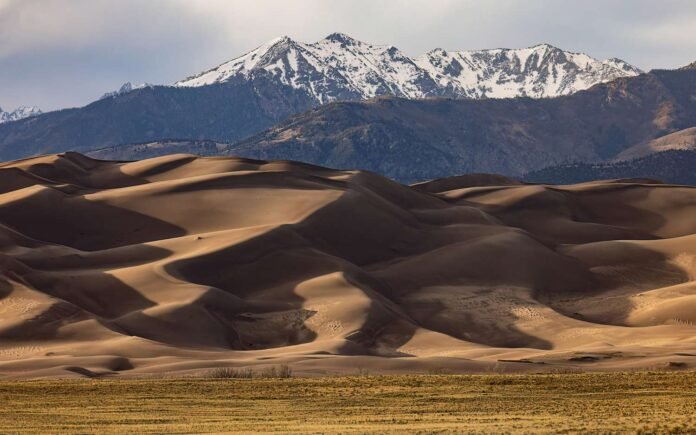Parcels proposed for an oil and gas lease sale in Colorado are not located on National Park Service land, according to a spokesman with the Colorado branch of the Bureau of Land Management.
Public criticism of the acreage located due east of the Great Sand Dunes National Park and Preserve have called the potential September 2018 lease sale offerings an “attack” on the park itself.
Between the park and the ten parcels stand the Sangre de Cristo Mountain Range, which features nine of Colorado’s “Fourteeners” and a ridgeline that approaches 11,000 feet in many places.
The Colorado State Senate’s 16 Democrats signed a letter opposing the lease sale.
“[E]xtraction and pollution must be kept far, far away from our public lands,” they wrote. The elected officials did not specify what distance would be appropriate in their letter.
State Senate Minority Leader Leroy Garcia (D-Pueblo) also opposed the sale in an op-ed at the Pueblo Chieftain, saying the “Great Sand Dunes are not for sale.”
“Great Sand Dunes National Park is under attack. One of our most spectacular natural wonders soon could be open for oil and gas drilling if the federal government has its way,” Garcia wrote.
The proposed parcels, however, are not located within the national park or preserve boundaries, nor in adjacent forest service land, according to a BLM Colorado spokesman.
Jayson Barangan, a public affairs specialist with the BLM Colorado field office oil and gas lease sales division, told Western Wire that the planned September 2018 oil and gas lease sales included 18,358 total acres in the parcels currently being reviewed.
He added that only 1,247 acres of the surface lands are BLM maintained, or 6.8 percent of the parcels on offer. The remainder of surface land, 93.2 percent, is privately owned.
All subsurface minerals are part of the federal mineral estate, the spokesman said.
BLM oversees 564 million acres of BLM-managed surface land and other agency-held lands, along with individual state and private lands where subsurface mineral rights “were retained by the Federal government,” another BLM spokesman previously told Western Wire.
The agency, located within the Interior Department, manages nearly 245 million acres of federal land throughout the country, with the vast majority located in the West.
This managerial oversight includes the responsibility for permitting natural resource production, including oil and gas, on nearly 700 million subsurface acres, such as those in Colorado.
According to Barangan, this proposed sale includes subsurface mineral rights with some parcels being offered featuring a mix of BLM and private land on the surface.
All parcels in this area are located in Huerfano county, whose western border is formed by the Sangre de Cristo ridgeline.
Gov. John Hickenlooper (D) did not join his legislative colleagues and will not protest the sale.
According to the Denver Post, he allowed the deadline for public comment to pass once he learned the parcels BLM is offering are located on the eastern side of the ridgeline of the Sangre de Cristo Mountains, running at nearly 11,000 feet.
None of the parcels touch the ridgeline, and a buffer of San Isabel National Forest land further separates the BLM parcels from the national park.
The governor’s spokeswoman says Hickenlooper’s administration will continue to monitor the situation.
State Senate President Kevin Grantham welcomed the lease sales.
“The operations are clean, they are quiet — all you have to do is visit them to see it,” he said. “It would be good for the economy down there, and they need some boost down there.”
Last month, the Denver Post editorial board considered the impact and the necessity to allow the BLM to conduct its environmental assessment. While noting the grandeur of the Great Sand Dunes National Park and Preserve—“a special place worthy of protection from all types of development”—it also pointed to the “natural buffer” of the Sangre de Cristos.
“All 18,000 acres under consideration for a lease auction in September are on the other side of the towering Sangre de Cristo mountains from the park,” the editorial board wrote.
“That’s a natural buffer that at times peaks at 14,000 feet and would protect the park from any ensuing light pollution, air pollution, unsightly temporary drilling rigs and heavy truck traffic. When taking that fact into consideration, the proximity of these proposed sites to the park become much less concerning, although clearly still a factor to consider,” they continued.
The sale notice for the September 6 auction will be released July 20, 2018. A ten-day protest period will follow, and the BLM’s final determination will be made after that review is complete.
Opponents of the proposed parcels acknowledge the topographical separation provided by the mountain range, but oppose it for other reasons as well.
“The parcels are in an area where there hasn’t been any kind of oil and gas production before,” said Kimberly Pope, a Sierra Club spokeswoman told High Country News. “It is a brand-new area with unknown resource availability that just doesn’t seem like a great choice for the BLM to be leasing.”
Barangan, BLM Colorado’s oil and gas lease media contact, told the Sierra Club’s magazine Sierra that, “There was some misinformation when this story was first announced,” specifically that the parcels were not within the park boundaries of Great Sand Dunes National Park.
“Great Sand Dunes National Park has over 300,000 visitors a year to experience the dark night skies, hike in the wilderness, and get some wonderful solitude that’s really hard to find anywhere else,” said Pope, who is the Sierra Club Our Wild America organizer in Colorado. “We’re not even sure there are resources available on these parcels.”

